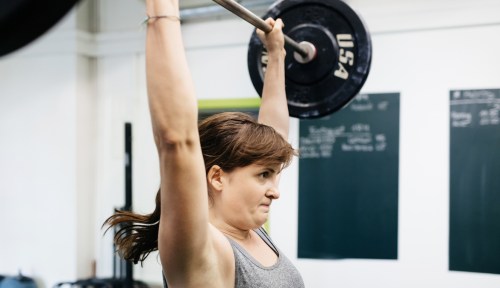Our editors independently select these products. Making a purchase through our links may earn Well+Good a commission
I’m nearing the end of my third set of overhead presses. My arms are quaking with the effort of lifting the dumbbells above my head. I create a power ball of energy deep in my core, and as I push it up my body, through my chest, back, shoulders, and arms, I screw up my face and emit a roar as I launch both weights toward the ceiling and power through the rep. My trainer laughs appreciatively over Zoom, and says “This is why I love working with you, Rachel. You always give it your all.”
“Yeah, and I look and sound so attractive when I do it,” I respond jokingly.
But I catch myself in the moment. Why am I thinking about how attractive I look when I’ve just beasted through a hard, and ultimately empowering, challenge? Even the description I use when reflecting—“beasted through”—has a negative connotation when it comes to the way I look.
I’ve realized that how “pretty” I look, versus how powerful and beastly I feel, when I work out has been on my mind lately.
I think part of it has to do with the fact that I recently returned to in-person fitness classes, attending some of my first group workouts since before the pandemic. And in those classes I couldn’t help but notice just how pretty and put together my classmates looked. From matching athletic outfits to perfect ponytails to makeup and eyelash extensions, these girls could be heading to brunch just as easily as a bootcamp. Is it just me, or has looking cute to go work out become even more of a norm than it was when I was going to the gym regularly, pre-pandemic? But it’s not just IRL that I’m noticing this trend.
For me, adding the expectation of looking good for a workout is another barrier to working out.
I can barely scroll through Instagram or TikTok without spotting a woman fully decked out in activewear like she’s on her way to an editorial shoot instead of the gym, or being served an ad for expensive, fashion-forward workout clothes. On TV shows, I’ve noticed matching sets replacing oversized sweats and big T-shirts when there’s a fitness scene. Could we be further from the days when Monica forced Chandler to exercise on Friends while wearing gray sweatpants? In some ways, it’s an example of art imitating life. According to a report in Forbes, athleisure purchases grew 84 percent over the first year of the pandemic. So maybe we all just have more fashionable workout clothes we’ve been dying to show off for two years.
Or maybe it’s that dopamine dressing makes some people more excited to exercise. In a survey of over 2,000 gym-goers, 69 percent said having nice workout clothing helps motivate them to go to the gym. “Dopamine motivates us to seek a reward,” behavioral psychologist Carolyn Mair, PhD, author of The Psychology of Fashion, previously told Well+Good. “So, scientifically speaking, dopamine dressing refers to a person’s motivation to dress in a way that will result in a positive outcome, like feeling more confident, competent, or happy.” Or perhaps, stronger, faster, or more fit?
That is all well and good—and dressing up certainly can be fun. But, for me (and the 31 percent of folks who don’t derive motivation from their gym outfits), adding the expectation of looking good for a workout session is another barrier to working out. Plus, I don’t necessarily find on-trend clothes, like crop tops, the most comfortable to work out in. I know I don’t like to bare my midriff when I’m working out in public because (as much as I try not to think about it), the way my stomach looks may be on my mind, and serve as a distraction.
For some people, maybe getting dressed to work out is a necessary part of their warm-up, and that is totally okay. But for me, it’s a relief to have a time when it’s fine to not have the way I look be top of of mind. From Zoom calls to Instagram Stories, the pressure to be presentable to the outside world is a lot of weight to carry on our shoulders—more than the dumbbells I’m lifting.
I also wonder if this emphasis on our appearance takes away from what we’re actually supposed to be focused on in the gym or studio: pushing our bodies? It won’t matter how much I’m wearing or whether my sports bra matches my biker shorts when I’m getting through a set like those overhead presses. I’m going to be grunting and sweating and pulling faces like I’m ready to lay siege to an enemy stronghold. It’s not “pretty,” in that it’s not prim, clean, symmetrical, effortless-seeming, put together, or conventionally “attractive.” But it’s powerful, and it’s me.
Sign Up for Our Daily Newsletter
Get all the latest in wellness, trends, food, fitness, beauty, and more delivered right to your inbox.
Got it, you've been added to our email list.










